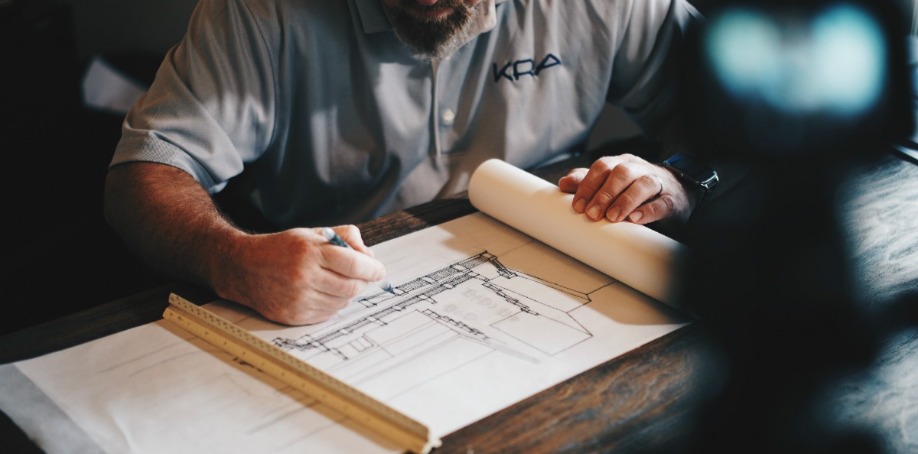
As little as 10 years ago, AV and IT integrators focused primarily on retrofitting existing buildings with updated technological tools. Today, however, tools and services like conference calling, video calls and chats, and webinars are ubiquitous. To ensure truly seamless use, these business technologies must be integrated into the structure of the building itself, recommends HB Communications.
Integrating tech into building design works best when integrators and architects communicate during the planning and design stages — a fact that is changing how integrators think about the contacts they make and the bids they construct. Here, we'll talk about why and how integrators can pitch to and collaborate with architects when designing AV-rich spaces.
Why Architects and Integrators Should Team Up
In the past two decades, architects have grown accustomed to planning for AV- or IT-specific space within their building designs, from making room for Ethernet cabling and servers to determining how much natural light should be available in a space designed for video conferencing. Integrators have also dedicated much time to learning the most cost-effective ways to retrofit buildings for today's technology.
As a 2006 Wall Street Journal interview with architect Frank Gehry notes, both approaches have worked toward a common goal: Seamless technology use inside a well-appointed workspace. Yet both have worked from opposite ends toward the middle.
Today, AV integrators are realizing that working from one end toward the middle often results in imperfect solutions, says Ken Graven, vice president with Charles M. Salter Associates, Inc. By working together at the design stage, architects and integrators start at the “middle” of the goal, maximizing both teams' chances of achieving it.
Below are some of the biggest reasons integrators and architects make a natural team:
Manufacturers and integrators are making it easier than ever to turn tech into design.
In the past, an architect's job ended with the engineering and design of thoughtful spaces. Today, however, AV technology manufacturers like Premiere Dedicated Solutions (PDS) have upped the game with options like curved video walls. These products can be retrofitted in certain spaces — but when they are included as part of a building's design from the very beginning, this opens up a whole universe of new use cases and placements.
Of course, an architect's imagination for these tech elements within a space must give way to the practicalities of installing, maintaining and upgrading them. Articulating both the options and the limits these AV products offer is one of the key ways integrators can position themselves as subject-matter experts when offering a bid.
A little planning now can save big headaches in the future.
When designing a space, architects take into account the need to incorporate utilities like HVAC systems, water and power. In the past several years, integrating IT infrastructure like CAT5 or CAT6 cabling, server space and other tools has become commonplace, as well.
But while architects are familiar with the need to make room for these vital features, they don't always position them in ideal locations for AV integration or IT maintenance, says Mike Bouissiere, design engineer at PDS. Designing power boxes and control rooms into the right locations can help ensure the harmony and efficiency of the space.
Aesthetics and efficiency aren't the only concerns, Bouissiere continues. In some cases, a lack of understanding of AV integration needs on the architect's part can lead to legal headaches, as well.
“A videowall can actually fail inspections such as ADA compliance if it extends more than four inches off the wall,” Bouissiere notes. “This doesn't leave a lot of room for error in structural design. Architects need to plan for this from the minute they design the wall.”
An integrator's input at this stage can be invaluable.
A little planning now can save big headaches in the future.
When designing a space, architects take into account the need to incorporate utilities like HVAC systems, water and power. In the past several years, integrating IT infrastructure like CAT5 or CAT6 cabling, server space and other tools has become commonplace, as well.
But while architects are familiar with the need to make room for these vital features, they don’t always position them in ideal locations for AV integration or IT maintenance, says Mike Bouissiere, design engineer at PDS. Designing power boxes and control rooms into the right locations can help ensure the harmony and efficiency of the space.
Aesthetics and efficiency aren't the only concerns, Bouissiere continues. In some cases, a lack of understanding of AV integration needs on the architect's part can lead to legal headaches, as well.
“A videowall can actually fail inspections such as ADA compliance if it extends more than four inches off the wall,” Bouissiere notes. “This doesn't leave a lot of room for error in structural design. Architects need to plan for this from the minute they design the wall.”
An integrator's input at this stage can be invaluable.

How to Integrate AV Into the Earliest Stages of the Building Design Process
“Our clients recognize that information and possibilities lie far beyond the four walls of their project,” architect Jennifer K. Cordes says. “Today’s buildings have the potential to link people to the outside world in real time.”
Realizing this same potential in their respective domains is essential for both architects and integrators — but it's only the first step in the process of creating buildings that realize this vision. Teamwork between architects, AV consultants and integrators is essential to success, says AV Magazine's George Cole.
Here's how to think about bidding in order to build relationships and pursue success:
Consider the task from the architect's point of view.
Architects are part artist at heart. In a successful architectural design, the general aesthetics of a space align harmoniously with its intended use and its structural soundness. With an eye on how the space is built, used and feels, however, architects may overlook the way in which their aesthetic element of choice makes the use of the space from an AV or IT perspective much harder. For example, an architect may place partitions in a meeting space in less-than-ideal settings, forcing integrators to work around them, CBI senior audio visual consultant Jerry Mason tells Cole.
In addition, considering cost from the architect's point of view can lead to a better working relationship, as well, says architect Stephanie Aurora Lewis. For instance, while tools like 3D rendering of plans may take more time, integrators who use them can provide a more comprehensive view of the project and the most cost-effective ways to meet both the integrator's needs and the architect's vision.
Examine the latest integration projects for inspiration.
AV integration from the ground up has resulted in some truly stunning recent projects, which integrators can study to understand how their work can be used to enhance a designed space — and how to communicate with architects who have design in mind.
For example, at the recently built Salesforce headquarters in San Francisco, integrators and architects worked together to incorporate an LED video wall on the elevator bank. “This could be a million-dollar addition, not because they need it, but because they want it,” notes Jonathan Brawn of Brawn Consulting. Teamwork at the design stage has resulted in a building that not only supports video walls in specified areas, but that positions them for maximum impact within the space.
Advanced Collaboration Group's work on the Barrick Gold conference rooms provides examples of ways in which customized skins and other design features can make AV technology feel as if it belongs to the space, while still providing “military-like precision” for videoconferencing and other features. The interactive video collaboration system was designed not only to meet the client's needs for video meetings with executives worldwide, but also to appear as if it were native to the space in which it was installed.
By working to install conference technologies in Venable LLP's newly constructed flagship office building, Tritech not only provided the office's 400 attorneys and staff with the tools they needed, but also balanced the needs of several different groups, including clients and other stakeholders. Careful attention to AV integration at the design stage makes it easier to identify and meet the needs of the diverse individuals who will interact with AV systems.
In a project for Philadelphia's new Museum of the American Revolution, Electrosonic demonstrated how participation from the start of the design process can lead to truly outstanding results. Electrosonic's work on the Washington war tent exhibit incorporated lighting, video, scrims and projectors to create a multimedia educational experience few museums can match — and that allows visitors to see George Washington's original war tent while still preserving it for future generations.
Integrators may find the inspiration to branch out, as well. In a project for Johns Hopkins University's Applied Physics Laboratory, Diversified provided not only cutting-edge video conferencing tools, but also surveillance solutions and security analytics, allowing researchers to emulate live video scenarios from the field. Working with architects to address security system concerns can likewise lead to a system that works without disrupting the building's atmosphere.

Architects and Integrators: A Natural Team
As with any other stakeholder, architects possess expertise in a specific area, which does not always extend to tech infrastructure or integration. By understanding an architect's viewpoint and drawing the lines between an architect's expertise and their own, integrators strengthen the compelling power of their bids and build relationships that result in better design.
Images by: rawpixel, Daniel McCullough, Tim de Groot


